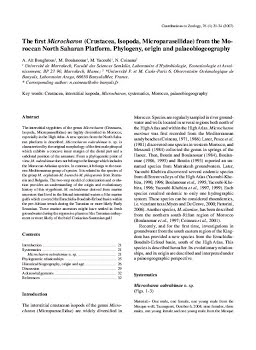2007
The first Microcharon (Crustacea, Isopoda, Microparasellidae) from the Moroccan North Saharan Platform. Phylogeny, origin and palaeobiogeography
Publication
Publication
Contributions to Zoology , Volume 76, 1 p. 21- 34
The interstitial stygobites of the genus Microcharon (Crustacea, Isopoda, Microparasellidae) are highly diversified in Morocco, especially in the High Atlas. A new species from the North Saharan platform is described. Microcharon oubrahimae n. sp. is characterized by the original morphology of the first male pleopod which exhibits a concave inner margin of the distal part and a subdistal position of the armature. From a phylogenetic point of view, M. oubrahimae does not belong to the lineage which includes the Moroccan Atlasian species. In contrast, it belongs to the eastern- Mediterranean group of species. It is related to the species of the group M. orghidani-M. bureschi-M. phlegetonis from Romania and Bulgaria. The two-step model of colonization and evolution provides an understanding of the origin and evolutionary history of this stygobiont. M. oubrahimae derived from marine ancestors that lived in the littoral interstitial waters of the marine gulfs which covered the Errachidia-Boudnib-Erfoud basin within the pre-African trench during the Turonian or more likely Early Senonian. These marine ancestors might have settled in fresh groundwater during the regressive phases of the Turonian embayment or more likely of the brief Coniacian-Santonian gulf.
| Additional Metadata | |
|---|---|
| , , , , , | |
| Contributions to Zoology | |
| Released under the CC-BY 4.0 ("Attribution") License | |
| Organisation | Naturalis journals & series |
|
Aït Boughrous, A., Boulanouar, M., Yacoubi, M., & Coineau, N. (2007). The first Microcharon (Crustacea, Isopoda, Microparasellidae) from the Moroccan North Saharan Platform. Phylogeny, origin and palaeobiogeography. Contributions to Zoology, 76, 1, 21–34. |
|
